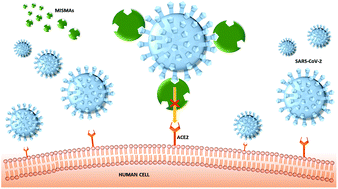Design and development of plastic antibodies against SARS-CoV-2 RBD based on molecularly imprinted polymers that inhibit in vitro virus infection†
Abstract
The present research study reports the development of plastic antibodies based on Molecularly Imprinted Polymers (MIPs) capable of selectively binding a portion of the novel coronavirus SARS-CoV-2 spike protein. Indeed, molecular imprinting represents a very promising and attractive technology for the synthesis of MIPs characterized by specific recognition abilities for a target molecule. Given these characteristics, MIPs can be considered tailor-made synthetic antibodies obtained by a templating process. After in silico analysis, imprinted nanoparticles were synthesized by inverse microemulsion polymerization and their ability to prevent the interaction between ACE2 and the receptor-binding domain of SARS-CoV-2 was investigated. Of relevance, the developed synthetic antibodies are capable of significantly inhibiting virus replication in Vero cell culture, suggesting their potential application in the treatment, prevention and diagnosis of SARS-CoV-2 infection.



 Please wait while we load your content...
Please wait while we load your content...